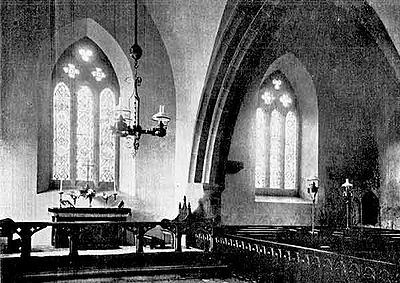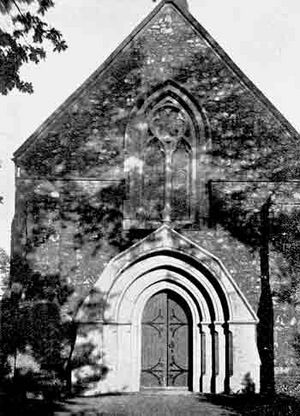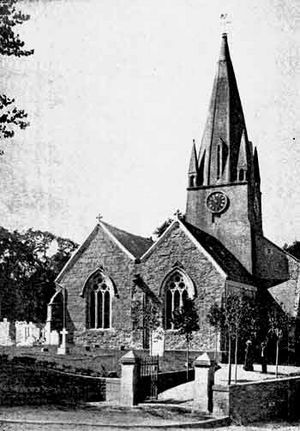St Mary's Parish Church
This article by R G Warton was first published in the 1920 Annual Bulletin of La Société Jersiaise
|
At the head of St Peter's Valley, one of the most beautiful in Jersey, over 300 feet above sea level, stands St Mary's Church alone.
Three miles to the south is St Aubin's Bay; less than one mile north, the little harbour of Greve de Lecq, probable port of the perquage, followed by malefactors, called upon to quit the island for the island's good. It forms a centre of roads, converging from the churches of St Ouen, St Peter, and St John.
Church of many names
St Mary is a church of many names - "Ste Marie" of the country folk, "Ecclesia Bearse Marire" of the old monks, "Sancta Maria arsi monasterii" (Ste Marie d'Arsmoutier) in reference to a monastery which in former times stood near by and was burned. This monastery stood on the site of the property known as The Elms, in the garden of which, a quantity of ecclesiastical architectural debris has been built into the walls.
It has been remarked how the subtle, and perchance unconscious, influence of scenery affected the church builders of olden days. They aimed apparently at work that should blend, rather than vie with nature. St Mary seems to offer an example of this artistic ideal.
Surrounded by tall and dark leaved trees it stands, with only one small building, the village inn, in contrast. Under less suitable environment it would probably appear to be of ordinary type; but here, its gray walls, and lofty spire, assume quite an imposing aspect.
As to its antiquity there can be no doubt. St Mary is one of the oldest in this island of ancient churches. It was, with St Martin's Church, granted to the abbey of Cerisy in 1042, by William Duke of Normandy, later "The Conqueror", and King of England (then known as "William the Bastard").
Ego Guillelmus Normannorum Dux dedi Abbatiae Cerasii in insula Gersoii duas ecclesias liberas scilicet ecclesiam Sancte Marie arsi monasterii et Sancti Martini veteris cum terris suis et tertiam partem decime de annona.
Actum anuo dominicoe incarnacionis millesimo quadragesimo secundo xii kalendas Maii (12 May 1042).
This charter was confirmed by the Conqueror's son, Henry 1 of England.
The Abbot of St Sauveur-le-Vicomte had the sixth part of the tythe of the sheaves; the Abbesses of Caen and Montivilliers, each the fourth part; the Rector the third part of the sixteen vergees of alms. The living was worth 30 livres tournois, or roughly, about £15 sterling per annum - hardly a living wage.
The rights of the Abbot and Abbesses were subsequently disputed; but the presentment of the Jurors of St Mary resulted in their favour.
The patron was the Abbot of Cerisy (Cerisiaicus), not of Cherbourg, (Caesaris-burgus) as stated in error by the local historian, Falle.
In 1066 William the Conqueror had confirmed the Abbey of Montivilliers in all the gifts which had been made to it, and had supplemented them by a grant of half the revenues of eight churches in the Island of Jersey, viz St Clement, St Martin, Grouville, St Helier, St Peter, St Brelade, St Ouen, and St Mary. He did this in presence of Matilda his wife, Roger Montgomery, William Fitz Osborn, and Raoul, his Chamberlain.
A bull of Pope John 23rd, dated 26 February 1414-15, authorized Jeanne d'Aumont, Abbess of Montivilliers, to sell the half of the revenues of these eight churches which William the Conqueror had so granted.
Oldest section
The north side is the oldest and original portion of this church; its nave, of 15th century date, being an extension of the chancel. About the same period, the southeast chapel was added, together with tower and spire. On the exterior of the east gable of the south chapel is a stone inscribed MCCCLII (1352), an important date, as it probably establishes the period of extension of this portion of the church.
Thus it remained till 1840, when a further enlargement, in the form of a south aisle, took place. The nave then consisted of only two spans, a third and smaller one being completed in 1864.
The church comprises some good Romanesque work. The windows and north and east wall of the chancel remain untouched, and are unmixed specimens of the style.
The east end is very good, consisting of two lights with a pilaster between. The interior has pointed vaulting, but the pilasters supporting it are cut away by the flamboyant arches of the south chancel or chapel, in which is a piscina exhibiting cable moulding, which is very rare in Jersey. Another instance occurs in one of the west doors of St Brelade’s Church. Over it is a singular triangular window richly crocketed.
A remarkable feature of the church is the low tower, exhibiting the development of the spire with Romanesque details, but of an outline hardly found in England till the later days of Early English.
The tower, rising only one story above the roof, had Norman windows, now partially obscured by the clock. The lantern displays the usual rude pointed arches and vaulting. It is crowned by a handsome hexagonal spire of the same character, and grouping well with it at the corners, square pinnacles, open, on rounded arches. The NE pinnacle bears the date 1834.
Spire
This spire is the same, on a smaller scale, as that of St Stephen's Church, Caen. It was struck by lightning in I874. The device C P D & Co (probably the initials of a contractor) disfigures its South face.
Small water-worn stones, used in the construction of the NE section of the church, suggest 13th century work, or possibly yet earlier. This section, as before stated, is antecedent to the SE chapel and nave, which are 15th century. When a south aisle was added in 1840, communication with the nave was effected, as in the case of other Jersey churches, by piercing the original south wall and substituting massive granite pillars, of transition type, to support the roof. This arcading forms an effective feature of the interior.
Being loftier than in most of the island churches its pillars do not obstruct the light, and tend to relieve the building of that somewhat gloomy aspect which has been frequently remarked in other cases.
The old Jersey custom (one with a patriotic tinge), of accommodating the parish artillery, within the precincts of the parish church, was duly observed. A wall was constructed to cut off the portion required for this purpose from the present chancel used for public worship. This arrangement continued until about 1830, when arsenals were provided by the States.
A recent addition (1861) is a west doorway, the necessity for which does not seem quite clear. Its design is more curious than artistic, a point impressed by the fact that it replaced a predecessor said to have been similar to the present porch of St Lawrence's Church, a deeply recessed and handsome specimen of early English work.
A sacristy and entrance to the belfry are other recent additions. The east windows are good examples of late Early English type. They are of the description styled "grisaille", displaying geometrical patterns on a tinted ground.
Inscriptions
Six circular ruby bands, on the chancel window, are inscribed, in French, as follows:
- Si vous ne mangez la chair du fils de l’homme, et ne buvez son sang
- Vouz n’avez point la vie vous mêmes
- Jesus leur dit, je suis le pain de vie
- C’est ici le pain qui est descendu du ciel
- Celui qui mange ma chair et qui boit mon sang
- a la vie éternelle
The east window of the south aisle consists of a simple "grisaille " pattern.
In 1902 the Collas family presented three memorial windows, which occupy adjacent positions at the SE end of the north aisle. Their respective subjects are:
- East – The Annunciation
- Centre – The Adoration
- West – the presentation of Christ in the temple
Previous to the latest restoration, in 1864, the windows and window tracery, were somewhat dilapidated and crude, with wooden sills. They now represent a late type of early English, and are well suited to the general character of the building.
Gallery
At the west end of the south aisle a square gallery has been introduced, rendered conspicuous by its light yellow tint. It may be useful as an organ loft, though not occupying an ideal position even for that purpose. In any case it detracts from the general appearance of the interior. A font, in Caen stone, of chalice pattern, occupies a position at the west end of the nave.
Speaking generally, the church furniture is not worthy of the church. It calls for renovation or renewal and is deficient in many of those accessories which tend to elevate and beautify the services. No reredos or triptich; no altar ornaments; no choir stalls, or screen. In such matters St Mary lags behind its fellows.
The church plate is not remarkable. It has been described in detail by Major Curtis in his paper on Jersey Church Plate where he remarks that it comprises the smallest number of pieces associated with any rectory in the Deanery. There are two cups, probably 17th century; two modern pieces, and two of the singular bowls on feet, similar to those at St Brelade. They are of identical shape, but being without marks, are difficult to assign to any particular date. They are probably of 17th century, and on account of their roughness of manufacture, of local origin.
Rectors and Deans
If, in some respects, St Mary hardly compares with other of our parish churches, it numbers several distinguished men among its clergy, -including four Deans of Jersey. Amongst them the following may be mentioned:
- David Bandinel: Rector 1620-26, Dean 1620-45; son Jacques succeeded him as Rector, 1626-43
- Thomas Le Breton: Rector 1706-28, Dean 1714-28
- Francis Payn: Rector 1729-65, Dean 1729-76
- Francis Le Breton: Rector 1765-77, Dean 1776-1802
- Samuel de la Place: Rector 1600-20
- Le Couteur Balleine: Rector 1856-79
- Edward Luce: Rector 1880-95, Honorary Canon of Winchester and Vice-Dean of Jersey
Mural monuments are not numerous. Amongst them are the following:
- Le Couteur Balleine ( -1879)
- Daniel Gruchy, Rector ( -1677)
- Thomas Le Breton, Dean ( -1728)
- Nicolas Arthur, Deputy ( -1885)
Amongst objects of minor interest the following may be mentioned. On the south wall a sundial bearing the inscription:
On the exterior of the western wall a curious stone is built in, (on its side) similar to one at St Ouen's Church. A solitary bell, inscribed:
Ste Marie, 1910
S Gruchy, Recteur
Ph Luce, ConnétablePoor box
An unusually large poor box, (tronc) inserted in the north wall, and doubly inscribed:- Jesus reqardait le peuple mettant de l’argent dans le tronc – St Marc xii 41
- Celui qui a pitié du pauvre préte à l’éternel et il lui rendra son bienfait – Prov xi 17
In popular estimation St Mary has been regarded as one of the plainer and less interesting of the Jersey parish churches. The same distinction has been somewhat gratuitously conferred on others. Be that as it may, this church possesses potentialities which, taken advantage of, would certainly relieve it of any such reproach. It has been previously pointed out that the exterior is by no means unworthy of its purpose.
The plan is simple, unpretentious, and free from the disfigurement which so-called restoration has inflicted upon some of its contemporaries. Curiously enough the familiar idea of a Latin Cross seems never to have been contemplated.
The interior is brighter and lighter than that of most Jersey parish churches. Rearrangement in some respects would no doubt be an improvement. A less crude disposition of pulpit and pews would commend itself to most present-day worshippers, the present arrangement probably having originated from the period when a movable altar was the fashion.
Again, the installation of organ and choir in a more conventiouul portion of the building might pave the way for the ultimate disappearance of the unsightly gallery they occupy. Other changes no doubt suggest themselves, involving small outlay, which would help to free St Mary from anachronisms, detracting from the symmetry and general appearance of the building and detrimental to the effectiveness of its services.
More costly matters would afford opportunity for combined effort, or, as in the case of so many of our parish churches, for the generosity of individual parishioners to step in. Thus, by degrees, this church, Ecclesia Beatae Mariae, would in time become yet more worthy of its age and ancestry.








